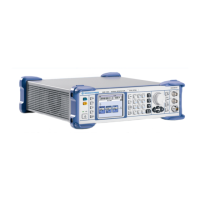Instrument Control
R&S
®
SMB100A
74Quick Start Guide 1407.0812.62 ─ 20
Most of the parameters are set in the different menus. The R&S SMB provides alterna-
tive ways for accessing the dialogs. Turn the rotary knob and navigate to the corre-
sponding block in the block diagram and press the knob to open the dialog or perform
a mouse click on the "Config..." button.
An exception are the "Setup" and "File" dialogs. In the "Setup" dialog, general settings
are made which are not directly concerned with signal generation, e.g. setting of the
GPIB-bus address. In the "File" dialog, files and lists are managed.
These menus can only be called with the [SETUP] (CTRL+E) and [FILE] (CTRL+S)
keys.
Frequency and level are directly set in the header area of the display using the [FREQ]
and [LEVEL] keys.
Specific settings can also be made directly in the block diagram, e.g. activating a func-
tion block by means of the [TOGGLE ON/OFF] (CTRL+T) key or switching the RF out-
put on and off with the aid of the [RF ON/OFF] (CTRL+R) key. Changes affecting the
signal flow are immediately visible in the graphics display.
This section provides an information about the parameter handling that comprises of
the following main steps:
●
Chapter 8.1.5.1, "Working with the Cursor", on page 74
●
Chapter 8.1.5.2, "Selecting a Control Element", on page 75
●
Chapter 8.1.5.3, "Switching Parameters On/Off", on page 75
●
Chapter 8.1.5.4, "Entering a Value", on page 75
●
Chapter 8.1.5.5, "Working with Units", on page 77
●
Chapter 8.1.5.6, "Selecting a Value from a List", on page 78
●
Chapter 8.1.5.7, "Terminating Entries with Confirmation", on page 78
●
Chapter 8.1.5.8, "Restoring the Previous Value", on page 79
8.1.5.1 Working with the Cursor
After the instrument is switched on, the cursor is always on the first function block of
the diagram (default setting).
Moving the cursor on the display
► To move the cursor, use one of the following alternative methods:
a) Use the rotary knob or the arrow keys.
b) Use the [Winbar] key to toggle between the active dialogs.
c) Use the [ESC] key.
Tip: Be aware that the function of the [ESC] key depends on the current cursor
position.
The function of this key depends on the current cursor position.
● Calls the next higher selection level.
● Closes the open window without accepting new entries; the old value or param-
eter is retained.
● In dialog boxes that contain a "Cancel" button it activates that button.
Manual Operation

